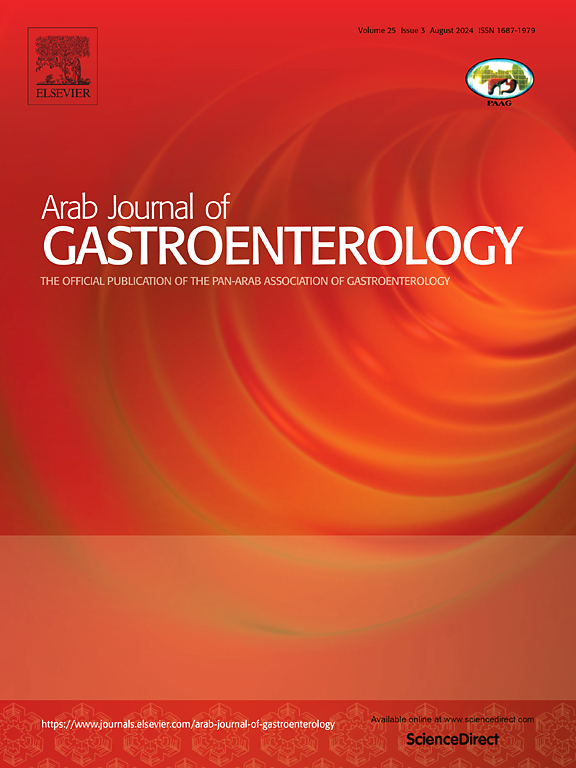通过瞬态弹性图、声辐射力脉冲和血清标志物评估,甲氨蝶呤诱导的肝纤维化被高估。
IF 1.1
4区 医学
Q4 GASTROENTEROLOGY & HEPATOLOGY
引用次数: 0
摘要
背景和研究目的:无创肝纤维化评估对于监测接受甲氨蝶呤(MTX)治疗的类风湿关节炎(RA)患者至关重要。本研究旨在检测MTX诱导的亚临床肝纤维化,采用FIB-4、APRI、瞬态弹性成像(TE)和声辐射力脉冲弹性成像(ARFI)进行评估。患者和方法:这项回顾性队列研究纳入了120名RA患者:60名患者接受MTX治疗,60名患者接受MTX和来氟米特(LEF)联合治疗。在入组时使用FIB-4、APRI、TE和ARFI进行肝纤维化评估。回顾性计算预处理FIB-4和APRI。结果:两组血清转氨酶水平保持在正常范围内,无论治疗或甲氨蝶呤持续时间。DAS 28评分表明患者在研究期间处于缓解期。在基线时(服用MTX之前),根据FIB-4, 114名患者(95%)表现出低纤维化风险,而6名患者(5%)被归类为中度风险。APRI显示117例(97.5%)患者表现为非显著纤维化,而3例(2.5%)患者表现为显著纤维化。入组后,两组FIB-4评分均较基线显著升高(0.56 vs 0.72;P = 0.0002和0.65 vs. 0.76;结论:使用te、ARFI和血清标志物评估甲氨蝶呤诱导的RA患者肝纤维化似乎被高估了。转氨酶不能作为接受mtx治疗的患者肝脏疾病或纤维化严重程度的预测因子。本文章由计算机程序翻译,如有差异,请以英文原文为准。
Methotrexate induced liver fibrosis is over estimated as assessed by transient elastography, acoustic radiation force impulse and serum markers
Background and study aims
Noninvasive assessment of liver fibrosis is critical for monitoring rheumatoid arthritis (RA) patients undergoing methotrexate (MTX). This study aimed to detect subclinical liver fibrosis induced by MTX assessed using FIB-4, APRI, transient elastography (TE), and acoustic radiation force impulse (ARFI) elastography.
Patients and methods
This retrospective cohort study enrolled 120 RA patients: 60 patients received MTX, and 60 received a combination of MTX and leflunomide (LEF). Liver fibrosis assessment was conducted using FIB-4, APRI, TE, and ARFI at the time of enrollment. Pretreatment FIB-4 and APRI were calculated retrospectively.
Results
Serum transaminase levels remained within normal ranges in both groups regardless of treatment or MTX duration. The DAS 28 score indicated that the patients were in remission at the study time. At baseline (prior to MTX administration), 114 patients (95 %) exhibited low fibrosis risk according to FIB-4, whereas 6 patients (5 %) were classified as intermediate risk. APRI indicated that 117 patients (97.5 %) exhibited non-significant fibrosis, whereas 3 (2.5 %) presented with significant fibrosis. Upon enrollment, there was a significant increase in FIB-4 scores compared to the baseline in both groups (0.56 vs. 0.72; P = 0.0002 and 0.65 vs. 0.76; P < 0.001). However, values remained within non-significant ranges. The LEF and MTX combination significantly increased APRI (0.35 vs. 0.37; P = 0.006) without reaching thresholds for significant fibrosis. TE and ARFI indicated non-significant fibrosis (F0–F1) in 116 patients (96.7) (58 per group) and moderate fibrosis (F2) in 4 patients (3.3 %). The duration of MTX treatment emerged as a significant predictor of liver fibrosis, albeit mild, as demonstrated by logistic regression analysis (OR 1.15, P = 0.008).
Conclusion
The assessment of MTX-induced liver fibrosis in RA patients, using TE, ARFI, and serum markers, appears to be overestimated. Transaminases did not serve as predictors of liver disease or fibrosis severity in RA patients undergoing MTX treatment.
求助全文
通过发布文献求助,成功后即可免费获取论文全文。
去求助
来源期刊

Arab Journal of Gastroenterology
Medicine-Gastroenterology
CiteScore
2.70
自引率
0.00%
发文量
52
期刊介绍:
Arab Journal of Gastroenterology (AJG) publishes different studies related to the digestive system. It aims to be the foremost scientific peer reviewed journal encompassing diverse studies related to the digestive system and its disorders, and serving the Pan-Arab and wider community working on gastrointestinal disorders.
 求助内容:
求助内容: 应助结果提醒方式:
应助结果提醒方式:


